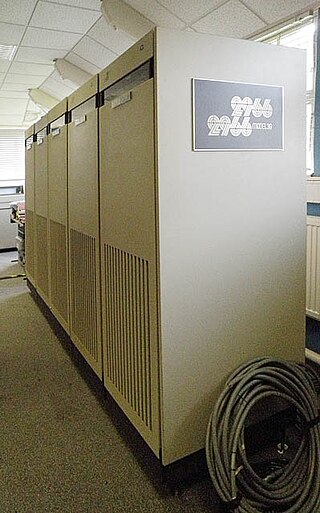Related Research Articles

The LEO was a series of early computer systems created by J. Lyons and Co. The first in the series, the LEO I, was the first computer used for commercial business applications.

A mainframe computer, informally called a mainframe or big iron, is a computer used primarily by large organizations for critical applications like bulk data processing for tasks such as censuses, industry and consumer statistics, enterprise resource planning, and large-scale transaction processing. A mainframe computer is large but not as large as a supercomputer and has more processing power than some other classes of computers, such as minicomputers, servers, workstations, and personal computers. Most large-scale computer-system architectures were established in the 1960s, but they continue to evolve. Mainframe computers are often used as servers.
VME is a mainframe operating system developed by the UK company International Computers Limited. Originally developed in the 1970s to drive ICL's then new 2900 Series mainframes, the operating system is now known as OpenVME incorporating a Unix subsystem, and runs on ICL Series 39 and Trimetra mainframe computers, as well as industry-standard x64 servers.

The IBM Series/1 is a 16-bit minicomputer, introduced in 1976, that in many respects competed with other minicomputers of the time, such as the PDP-11 from Digital Equipment Corporation and similar offerings from Data General and HP. The Series/1 was typically used to control and operate external electro-mechanical components while also allowing for primitive data storage and handling.
The Edinburgh Multi-Access System (EMAS) was a mainframe computer operating system at the University of Edinburgh. The system went online in 1971.

International Computers Limited (ICL) was a British computer hardware, computer software and computer services company that operated from 1968 until 2002. It was formed through a merger of International Computers and Tabulators (ICT), English Electric Computers (EEC) and Elliott Automation in 1968. The company's most successful product line was the ICL 2900 Series range of mainframe computers.

The Integrated Database Management System (IDMS) is a network model (CODASYL) database management system for mainframes. It was first developed at B.F. Goodrich and later marketed by Cullinane Database Systems. Since 1989 the product has been owned by Computer Associates, who renamed it Advantage CA-IDMS and later simply to CA IDMS.

The ICL 2900 Series was a range of mainframe computer systems announced by the British manufacturer ICL on 9 October 1974. The company had started development under the name "New Range" immediately on its formation in 1968. The range was not designed to be compatible with any previous machines produced by the company, nor for compatibility with any competitor's machines: rather, it was conceived as a synthetic option, combining the best ideas available from a variety of sources.
DME may refer to:
The NAG Numerical Library is a software product developed and sold by The Numerical Algorithms Group Ltd. It is a software library of numerical analysis routines, containing more than 1,900 mathematical and statistical algorithms. Areas covered by the library include linear algebra, optimization, quadrature, the solution of ordinary and partial differential equations, regression analysis, and time series analysis.
S3 is a structured, imperative high-level computer programming language. It was developed by the UK company International Computers Limited (ICL) for its 2900 Series mainframes. It is a system programming language with syntax influenced by ALGOL 68 but with data types and operators aligned to those offered by the 2900 Series. It was the implementation language of the operating system VME.
The ICL Series 39 was a range of mainframe and minicomputer computer systems released by the UK manufacturer ICL in 1985. The original Series 39 introduced the "S3L" processors and microcodes, and a nodal architecture, which is a form of Non-Uniform Memory Access.
CADES was a software engineering system produced to support the design and development of the VME/B Operating System for the ICL New Range - subsequently 2900 - computers.

Brian Warboys, was a British Professor of Software Engineering at the University of Manchester from 1985 until he retired in September 2007. He was subsequently appointed as Professor Emeritus and continues to undertake research. Before joining the university he had worked for ICL, then the UK's largest computer manufacturer. During the 1970s he had been the chief designer of ICL's VME operating system. He is also the author of several non-fiction books.
GEORGE was the name given to a series of operating systems released by International Computers and Tabulators (ICT) in the 1960s, for the ICT 1900 series of computers. These included GEORGE 1, GEORGE 2, GEORGE 3, and GEORGE 4.
MINIMOP was an operating system which ran on the International Computers Limited (ICL) 1900 series of computers. MINIMOP provided an on-line, time-sharing environment, and typically ran alongside George 2 running batch jobs. MINIMOP was named to reflect its role as an alternative to the MOP facilities of George 3, which required a more powerful machine.

The ICL 7500 series was a range of terminals and workstations, that were developed by ICL during the 1970s for their new range ICL 2900 Series mainframe computers. The colour scheme was compatible with the 2900. The term 7561 is a commonly used though loose term for the interactive video aspects of the 7502 series. The 7501 and 7502 systems were known as Modular Terminal Processors in marketing publications. 7501 and 7502 systems were built at Blackhorse Road, Letchworth.
ICT 1900 was a family of mainframe computers released by International Computers and Tabulators (ICT) and later International Computers Limited (ICL) during the 1960s and 1970s. The 1900 series was notable for being one of the few non-American competitors to the IBM System/360, enjoying significant success in the European and British Commonwealth markets.

John Kenneth Iliffe was a British computer designer who worked on the design and evaluation of computers that supported fine-grained memory protection and object management. He implemented, evaluated and refined such designs in the Rice Institute Computer, R1 (1958–61) and the ICL Basic Language Machine (1963–68). A key feature in the architectures of both machines was control by the hardware of the formation and use of memory references so that the memory could be seen as a collection of data objects of defined sizes whose integrity is protected from the consequences of errors in address calculation, such as overrunning memory pointers.
References
- ↑ "ICL woos old users with new software". New Scientist. 28 April 1997. Retrieved 11 February 2011.
- ↑ "TP3788 DME/3 and CME/3" (DJVU). ICL. Retrieved 11 February 2011.